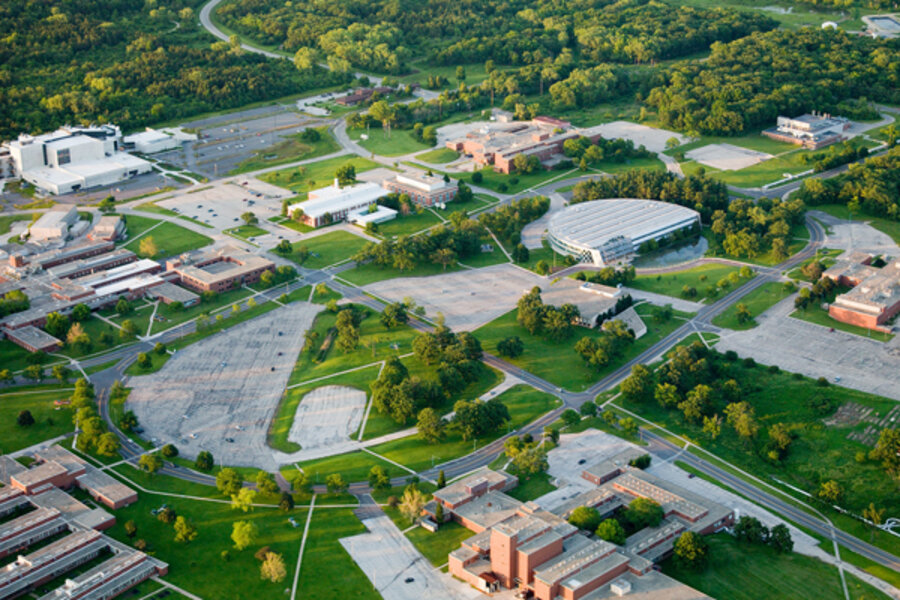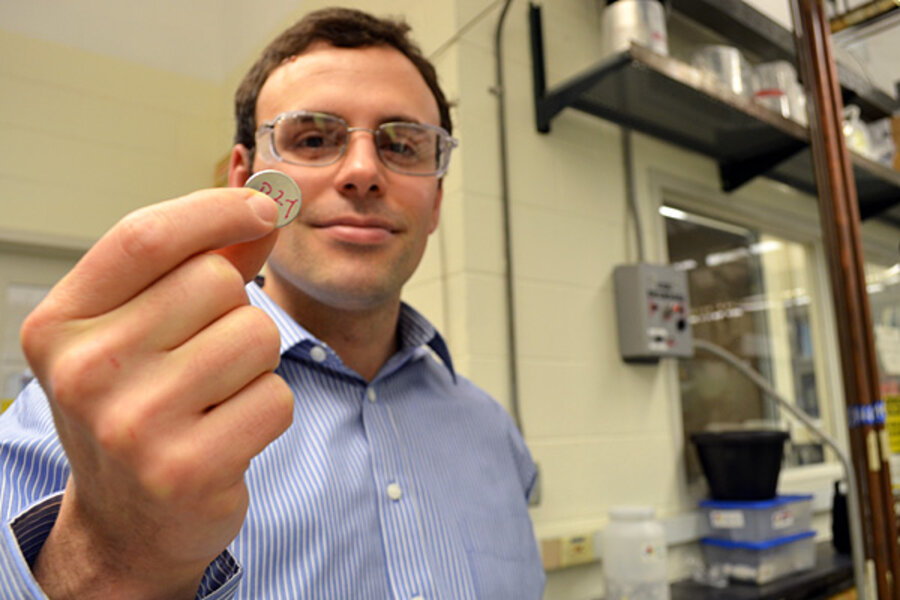Obama at Argonne lab: Why batteries matter
Loading...
| Boston and Lemont, Ill.
President Obama's visit to the center of a national energy-storage-research effort Friday highlights an overlooked tool in the administration's push for renewable energy: batteries.
The technology is ubiquitous – in our phones, our cars, and our planes – but the science is far from simple. The challenges are well-documented in news stories about bankrupt batterymakers, winter-averse electric cars, and grounded Dreamliners.
Many in the energy community believe we need a better battery. That's the focus of the work under way at the Joint Center for Energy Storage Research (JCESR) at Argonne National Laboratory in suburban Chicago – and the reason for Mr. Obama's visit. The president is expected to urge Congress to provide an additional $2 billion for battery and transportation research meant to end the nation's use of oil.
Better batteries would not only extend the range of electric-only and hybrid cars, they would also make the nation's electric grid a lot "greener," capable of storing energy from wind turbines and solar panels on a large scale and then delivering it when the wind isn't blowing and the sun isn't shining.
"It’s not glitzy; it’s not glamorous," said Donald Sadoway, a battery researcher at the Massachusetts Institute of Technology (MIT) in Cambridge, Mass., in a phone interview. "But – boy – if this thing works, it has enormous benefit."
How hard can it be?
In its simplest form, storing energy is like pushing a boulder uphill. The physical effort is stored in the boulder as potential energy. When it rolls back downhill, this "battery" is "discharged."
The challenges are comparably Sisyphean in advanced energy storage. As the president will likely see on his tour of the lab Friday, researchers at Argonne are trying to pack boulder-sized energy into smaller and smaller packages.
"[W]e're moving mass around," explained Kevin Gallagher, an electrochemical engineer with JCESR (pronounced "jay - caesar"). "It's not just moving electrons or photons. That would happen in telecommunications or in a computer chip," he said in an interview at Argonne last month. "We're moving mass."
In the case of a lithium-ion batteries – the kind used in most of our electronics – it's an ion that passes to and from anode to cathode, through an electrolyte. Depending on the direction, that process either stores energy or releases it.
“Whether you know it or not, every time you plug in your phone or laptop, you are reversing a chemical reaction," said Jeff Chamberlain, deputy director of development and demonstration at JCESR, in a telephone interview. "To make a good battery, you want to make the chemical reaction reversible, thousands of times. It’s just not easy.”
The challenge is that this process generates heat and shortens the life span of the battery. Sometimes it generates too much heat, as was the case with the smoldering batteries in the now-grounded Boeing 787 Dreamliners.
Advanced batteries are also expensive. It will take a lot of work before they come close to competing with the price points of gasoline.
But the payoffs of doing so would be significant – for both the electrical grid and our transportation network.
Internal combustion is a one-way street. After you spend the gas in your car's tank, you don't get that energy back. You go and get more gas.
The energy generated in electrochemistry, however, is renewable.
"That’s really important," Mr. Chamberlain said, "because now I can plug my car into my wall and put 'fuel' back in my car. Think about the implications about that in terms of a new green society.”
There are also implications for the fossil-fuel-based electrical grid we have now. The current system is inefficient and must constantly balance supply with demand. When you turn on a light bulb, that electricity isn’t much more than a few minutes old.
A grid-scale battery could act as a buffer, easing the stresses of daily demand spikes. Power plants could squirrel away energy at night when demand is low. That means there would be a reservoir of power available for when everyone wakes up and turns on the lights at roughly the same time.
Mr. Sadoway of MIT compares it to driving a car. You are most efficient when cruising steadily at highway speeds and least efficient when accelerating. Power plants follow a similar start-and-stop pattern. They ramp up in the morning and ramp down at night.
“It’s an inefficient use of the generating capacity and it generates more pollution,” Sadoway said. “You’ve already got the capital cost of the plant there, just put it in the sweet spot and run it 24/7 and use the battery as your ballast.”
Beyond lithium
Sadoway believes the energy-storage solution lies not in the more-exotic lithium but in cheaper, earth-abundant metals. He’s started a company, Ambri, and hopes to have a commercial prototype of a liquid-metal battery sometime next year.
Chamberlain, Mr. Gallagher, and the rest of the JCESR team are also moving beyond lithium. Among other options, they’re exploring the possibilities of inserting atoms, like magnesium or yttrium ions, into a host material's mesh-like atomic structure (a process known as multivalent intercalation). That has the potential to carry twice or triple the charge and storage capabilities of lithium.
They have given themselves an ambitious timeline – five years to develop batteries that are five times cheaper and five times more energy dense. That goal is at the limit of theoretical possibility, Chamberlain said.
“But we did that on purpose,” he added. “We know they’re aspirational goals, and even if we get halfway there it’s going to have an enormous impact.”









